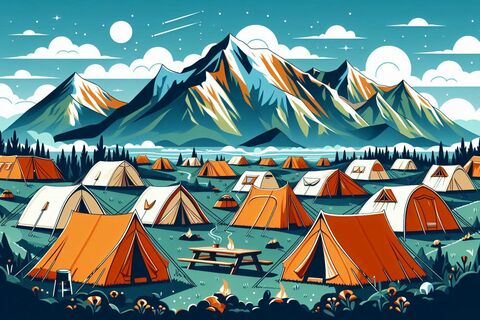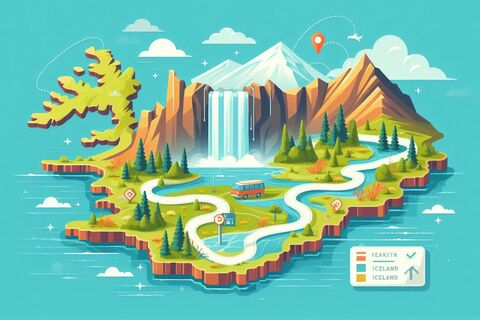Visiting Iceland in December
December in Iceland is a magical time when the country transforms into a winter wonderland. From snow-covered landscapes to festive Christmas celebrations, Iceland offers a unique experience during this time of year. However, traveling in December requires some preparation due to the unpredictable weather. This comprehensive guide covers everything you need to know about visiting Iceland in December, including essential travel tips, activities, and what to pack.
Why visit Iceland in December?
Northern Lights: December is one of the best months to witness the Northern Lights. With longer nights and dark skies, your chances of catching a glimpse of this natural phenomenon are higher, especially in remote areas away from city lights.
Festive atmosphere: Icelanders embrace the holiday spirit, and Reykjavik comes alive with Christmas lights, markets, and festive decorations. Unique traditions, like the 13 "Yule Lads" (Icelandic Christmas trolls), add a special charm to the celebrations.
Snowy landscapes: The country’s waterfalls, glaciers, and black sand beaches look even more stunning with a dusting of snow. December is the perfect time to capture breathtaking winter photos.
Fewer tourists: December is part of Iceland's off-season, meaning popular tourist spots like the Golden Circle and the South Coast are less crowded, allowing for a more intimate experience.
What’s the weather like in Iceland in December?
Iceland’s December weather is known for being cold and unpredictable. Here’s what you can expect:
- Temperature: The average temperatures range between -1°C and 4°C (30°F to 39°F) in the south, while northern areas can be much colder, dropping below -10°C (14°F) at times.
- Precipitation: December is a wet month with a mix of snow and rain. Strong winds are also common, so be prepared for changing weather conditions.
- Daylight Hours: Expect very short days. Around the winter solstice (around December 21st), there are only 4-5 hours of daylight. This means planning your activities around limited daylight is crucial.
What to pack for Iceland in December?
Packing the right gear is essential to enjoy your winter trip to Iceland. Here’s a packing checklist:
- Thermal layers: Use the 3-layer system (thermal base layer, insulating fleece, and a waterproof outer layer) to stay warm and dry.
- Waterproof pants: Essential for keeping you dry during snow or rain showers.
- Insulated boots: Waterproof, non-slip boots are a must for walking on icy paths and snowy terrain.
- Warm accessories: Pack a beanie, gloves (preferably insulated), and a scarf to protect against the cold wind.
- Moisturizer and lip balm: The cold, dry air can be harsh on your skin.
- Headlamp: With limited daylight, a headlamp is useful for outdoor activities that may extend into the dark.
Top things to do in Iceland in December
Chase the Northern Lights
December offers prime conditions for viewing the Northern Lights. To maximize your chances, head to remote areas like the Snæfellsnes Peninsula, East Fjords, or Þingvellir National Park. Joining a guided Northern Lights tour can also increase your chances of a successful sighting.
Explore ice caves
December marks the beginning of the ice cave season. These natural formations inside glaciers are a must-see, with some of the most stunning caves located within Vatnajökull Glacier. Note that ice caves can only be explored with a guided tour for safety reasons.
Soak in hot springs
Relaxing in a geothermal hot spring surrounded by snow-covered landscapes is a quintessential Icelandic experience. Beyond the popular Blue Lagoon, consider visiting the Secret Lagoon in Flúðir or the Myvatn Nature Baths in the north.
Winter hiking
While some trails may be snowy or icy, winter hikes in Iceland can be incredibly rewarding. Skaftafell in Vatnajökull National Park is a popular spot, with the iconic Svartifoss waterfall surrounded by frozen basalt columns. Remember to bring crampons for better traction.
Enjoy Reykjavik’s Christmas festivities
Reykjavik is charming in December with Christmas markets, festive lights, and special events. Don’t miss strolling along Laugavegur street for shopping and trying out traditional Icelandic holiday treats like "laufabrauð" (crispy bread).
Drive the South Coast
The South Coast is stunning in winter, with highlights like Seljalandsfoss and Skógafoss waterfalls, the black sand beach at Reynisfjara, and the Jokulsarlon Glacier Lagoon. Be prepared for winter driving conditions if you plan to rent a car.
Tips for driving in Iceland in December
Driving in Iceland during December can be challenging due to snow, ice, and strong winds. Here are some tips to ensure a safe journey:
- Rent a 4x4 vehicle: A four-wheel-drive vehicle with winter tires is highly recommended for navigating icy roads, especially if you plan to venture outside Reykjavik.
- Check weather and road conditions: Always check vedur.is (weather forecast) and road.is (road conditions) before heading out. Road closures and hazardous conditions are common in winter.
- Drive slowly and cautiously: Black ice and sudden gusts of wind can make driving treacherous. Adjust your speed accordingly and be aware of changing conditions.
- Fuel up frequently: Gas stations can be sparse in remote areas, so make sure to refuel whenever possible.
Best places to stay in Iceland in December
While many hotels and guesthouses remain open year-round, some remote accommodations may close for the winter. Here are some recommended places to stay:
- Reykjavik: A great base for exploring the southwest and enjoying the city’s festive atmosphere.
- Vík: Ideal for exploring the South Coast, with easy access to nearby attractions like Reynisfjara Beach and Skógafoss.
- Akureyri: Known as the “Capital of the North,” this town offers winter sports and scenic fjord views.
- Hofn: Perfect for exploring the glaciers in the southeast region.
Pros and cons of visiting Iceland in December
Pros:
- Stunning winter landscapes covered in snow.
- Fewer tourists, allowing for a more peaceful experience.
- Excellent opportunities for Northern Lights sightings.
- Festive Christmas atmosphere in Reykjavik.
Cons:
- Short daylight hours limit the time for sightseeing.
- Cold and unpredictable weather can disrupt travel plans.
- Some attractions, especially in the Highlands, may be inaccessible due to snow.
Conclusion: Is December a good time to visit Iceland?
Visiting Iceland in December offers a truly magical experience, from snowy landscapes to festive celebrations and the elusive Northern Lights. However, it’s important to be prepared for the cold weather, shorter days, and winter driving conditions.



